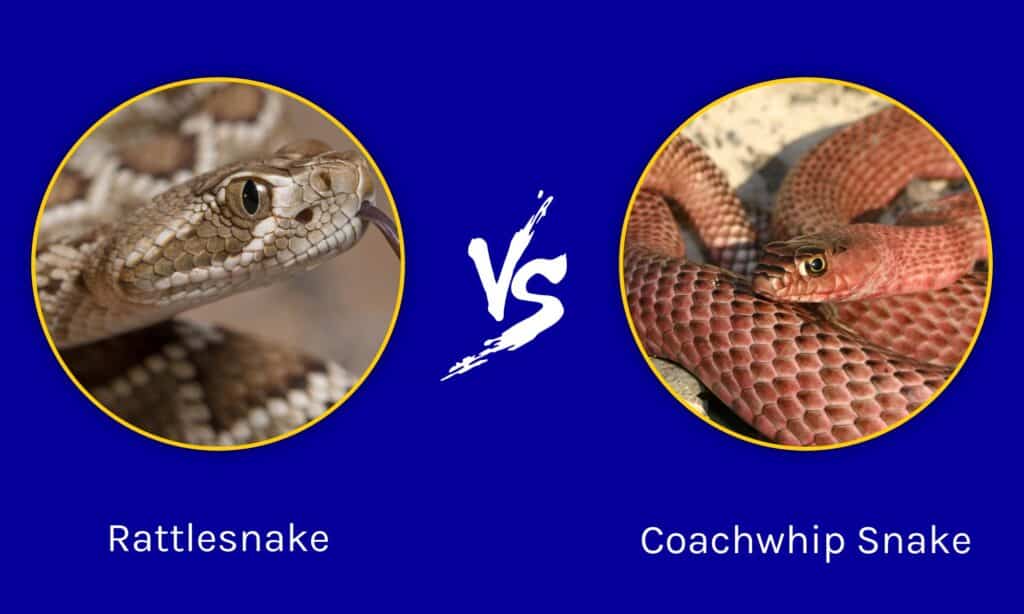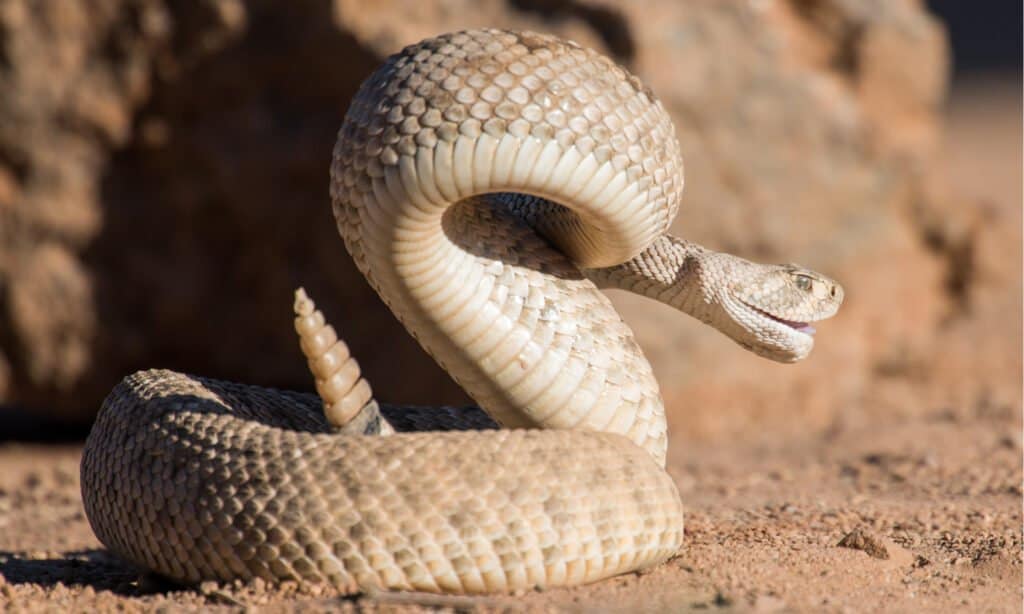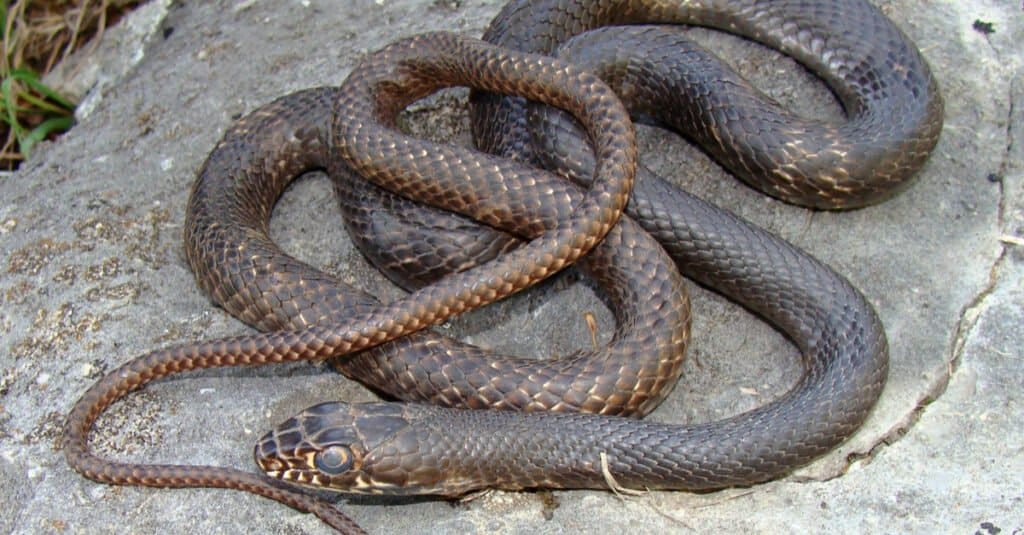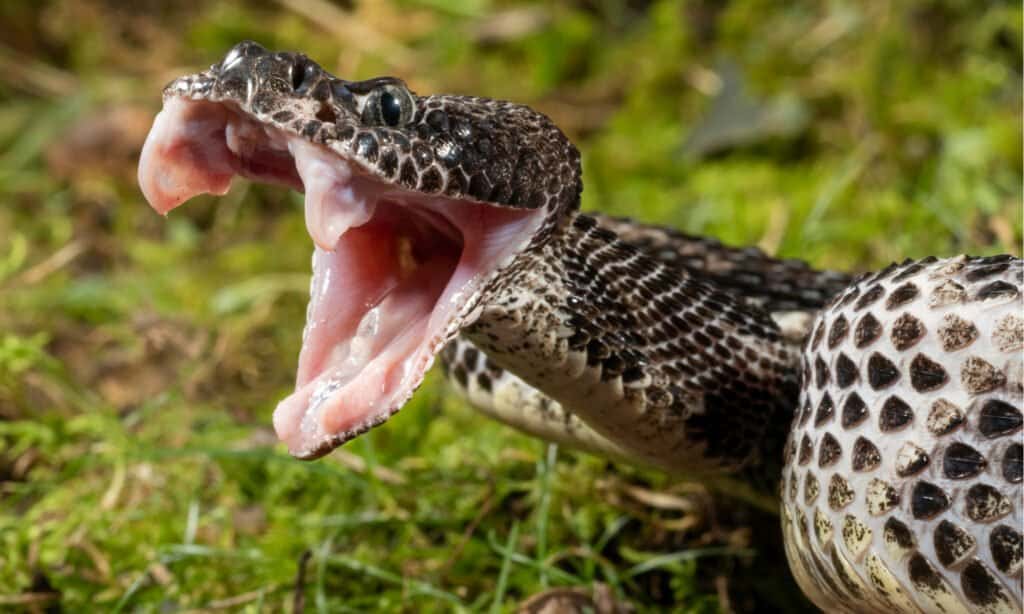Rattlesnakes have that characteristic rattle on the ends of their tails, and coachwhip snakes are crosshatched like old leather worked whips. The way they get their name is different, so what else is different between a coachwhip vs rattlesnake?
Rattlesnakes are found exclusively from Argentina to southern Canada. The biggest concentration of them is in the American southwest and northern Mexico. The coachwhip is also in the American southwest and northern Mexico, as well as most of the American south and parts of California.
Let’s look at 4 major differences and some facts about both snakes.
Comparing Coachwhip Snakes and Rattlesnakes

| Coachwhip | Rattlesnake | |
|---|---|---|
| Venom | Nonvenomous | Venomous |
| How They Bite | Chewing | Pierce Once with Fangs |
| Appearance | Color Gradient | Patterned |
| Lifespan | Up to 16 Years | Average around 13 years |
| Average Weight | 3 lbs. | 10 lbs. |
| Length | Up to 8 ft | Up to 8 ft |
| Hibernation (Brumation) | Yes | Yes |
Coachwhip Snake vs Rattlesnake: 4 Major Differences

Rattlesnakes are known for the characteristic rattle on the ends of their tails.
©Susan M Snyder/Shutterstock.com
The main difference between a rattlesnake and a coachwhip snake is the fact rattlesnakes are venomous while coachwhips are nonvenomous. In addition, they have significant differences in their appearance with rattlesnakes being thicker and having a distinctive rattle on the end of their tail.
Let’s dive into the differences between these two snakes and then look at some of their similarities as well.
Heads, Appearance, and Venom
Rattlesnakes are venomous whereas coachwhip snakes are not.
Rattlesnakes are pit vipers. This means they have a sensory organ in pits on their face that are heat sensitive. These pits can detect warm-blooded prey outside of their sight and poor hearing. They are the most evolved of all snakes, partially because of these pits, which also means they are the newest to appear.
Coachwhips do not have heat-sensing pits on their face. They primarily rely on their sense of smell and their vision to stalk and catch their prey. Coachwhips have round pupils while rattlesnakes have cat-eye pupils.
Rattlesnakes also have hinged fangs which they use to puncture skin and administer venom, while the coachwhip has sharp teeth that cut as it bites. Coachwhip snakes are nonvenomous and don’t need fangs to inject anything.
Coloring
Rattlesnakes have varying colors based on their regions, but generally have a diamond pattern on their backs cast across a lighter body background.
Coachwhips have a crosshatched scale appearance and are usually white or tan at the tail with a dark brown or black head. The color stretches across their body like a gradient. Some coachwhips can be pinkish or red, but the color still streaks across the snake all the same.

Coachwhip snakes appear to be crosshatched like an old whip.
©Matt Jeppson/Shutterstock.com
Age and Number of Species
Rattlesnakes have average lifespans of about 13 years old whereas a coachwhip lives to be about 16. There are dozens of subspecies of rattlesnakes branching from 56 different species. These include the prairie, timber, and Mojave rattlesnakes. The coachwhip species has 7 subspecies.
While specific rattlesnakes and coachwhip snakes are endangered, the two snakes still have a decent population size. One of the biggest threats is human development that’s encroaching on their habitats.
Tails and Rattle
Rattlesnakes have a rattle on the ends of their tails which are made of keratin. Keratin is the same protein that makes up human fingernails. These chambers are hollow, and when the snake shakes its tail, they knock together and create a rattling noise. Whenever a rattlesnake sheds its skin, it gets a new rattle segment. Their tails are prone to breakage, just like human nails.
Coachwhip snakes are slender and long, whereas rattlesnakes are much heftier. A coachwhip, on average, weighs about a pound whereas the biggest rattlesnake on record weighed 34 lbs. Rattlesnakes average about 10 lbs., which is much heavier than a 3 lb. coachwhip.
Coachwhip Snake vs Rattlesnake: How Are They the Same?
Both the coachwhip snake and the rattlesnake can grow up to 8 feet in length. They both like to sunbathe during the daytime and hang out in their burrows at night. Both have colors that vary based on habitat so they better blend into their surroundings.
Rattlesnakes live in dens that they find in rocky areas, and they hibernate in the winter. This hibernation is called brumation. Coachwhip snakes also go through a period of brumation.
Coachwhip Snake vs Rattlesnake: Are They Venomous?
The coachwhip snake is not venomous while the rattlesnake is. The rattlesnake relies on its venom to overcome its prey. Both snakes aren’t looking to confront humans and usually only attack when cornered or surprised.
The amount of venom a rattlesnake uses when it bites is under its control. Rattlesnakes and other venomous snakes in the United States are responsible for 8,000 bites per year, but on average, only 5 people die as a result. Almost all people who hike in the southwest know about rattlesnakes and take proper precautions to avoid encounters.
It’s untrue that baby rattlesnakes deliver more venom than adults. They have full control over their venom but have smaller quantities than what you’d receive from a mature snake’s bite.

Despite popular opinion, baby rattlesnakes are not more venomous than adult rattlesnakes.
©Joe McDonald/Shutterstock.com
Coachwhip Snake vs Rattlesnake: Defensive Postures
Rattlesnakes, along with their characteristic tail rattle, hiss when confronted. A rattlesnake will coil in on itself and hold its head high. What makes them exceptionally dangerous is they can land a bite on their target from over a third of their body length away.
A coachwhip will raise its head high and bite whatever is threatening it. Coachwhips, unlike rattlesnakes, don’t just bite once, they gnaw on their target. Rattlesnakes envenomate with one strike from their fangs, while coachwhips chew a little bit if they land a bite on a human.
Rattlesnakes do have a few predators with their major danger being the kingsnake. Hawks, owls, eagles, foxes, roadrunners, and coyotes also eat rattlesnakes.
Coachwhips are better equipped to run away as they travel up to 4 miles per hour, whereas rattlesnakes can only flee at 2 to 3 mph. It doesn’t sound like much of a difference, but it can mean the difference between life and death in the animal world.
Baby Coachwhip Snake vs Baby Rattlesnake: Are They Dangerous?
Baby rattlesnakes are dangerous. They have not yet developed a rattle through shedding and can’t signal their location with it. They’re easier to sneak up on and they’re aggressive. However, they’re not any more dangerous than adults.
Baby coachwhip snakes are also no more dangerous than adults since they chew. There’s no venom to worry about. Like with any snake, the bigger the snake, the more damage it can do.
Baby rattlesnakes are born whereas coachwhips hatch from eggs that the mother lays. In either case, the juveniles are expected to be independent from the day their body hits the ground. Neither snake mothers in any way.
The photo featured at the top of this post is © Scott Delony/Shutterstock.com
Discover the "Monster" Snake 5X Bigger than an Anaconda
Every day A-Z Animals sends out some of the most incredible facts in the world from our free newsletter. Want to discover the 10 most beautiful snakes in the world, a "snake island" where you're never more than 3 feet from danger, or a "monster" snake 5X larger than an anaconda? Then sign up right now and you'll start receiving our daily newsletter absolutely free.
Thank you for reading! Have some feedback for us? Contact the AZ Animals editorial team.







